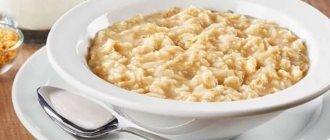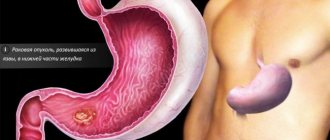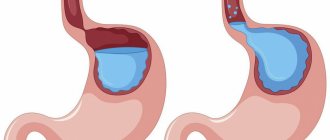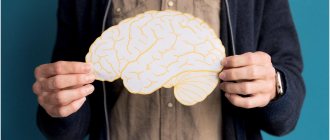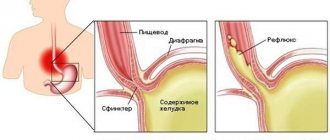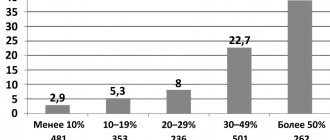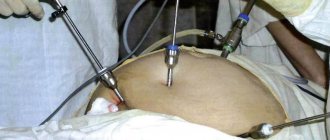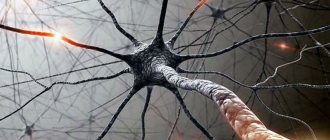The esophagus is a hollow tube consisting of muscle tissue. The main function of this organ is to move food from the pharynx to the stomach. When the esophagus is healthy, the muscle tissue contracts and gradually moves food out. The person does not experience any discomfort; this process is painless.
If smooth, wave-like movements become sharp and convulsive, pain, spasm and, as a result, panic occurs. In this case, it is imperative to find out the reason causing this condition, because the cause may be a serious illness.
Symptoms and causes of spasms
Esophageal spasm - painful sensations
Spasm is an uncontrolled and painful compression of the esophagus tube in different parts, in which food stops its movement through the esophagus.
Symptoms accompanying spasm:
- a feeling of heaviness and the presence of a foreign object in the throat;
- difficulty swallowing;
- pain not only in the throat area, but also under the shoulder blade, behind the sternum.
Symptoms appear rarely at first, sporadically, becoming more frequent over time, and not only during meals or water. Symptoms of spasms include: pain, severe and sharp, or a lump is felt in the area, heaviness and constriction, difficulty swallowing, even if the food is liquid.
Trial of proton pump inhibitor therapy
A test involving short-term therapy with high doses of a proton pump inhibitor for non-cardiac pain has both diagnostic and therapeutic value.
Patients are prescribed 60-80 mg/24 hours of omeprazole, esomeprazole or pantoprazole and 30-90/24 hours. lansoprazole. Duration of trial therapy is up to 28 days. The sensitivity of this test is estimated at 69–95% and specificity at 67–86%.
Patients who do not respond to treatment attempts with proton pump inhibitors should undergo the following procedures:
- daily impedance-pH-metry of the esophagus, which makes it possible to diagnose non-acid reflux, the symptoms of which persist after such treatment;
- esophageal manometry, diagnosing esophageal motility disorders;
- in cases of chest pain not associated with GERD or esophageal motility disorders, after excluding other causes, a consultation with a psychiatrist is prescribed.
Treatment depends on the type and severity of the condition causing chest pain.
Causes of spasms
Esophageal spasm
Spasms can occur from chronic lack of sleep, fatigue, if a person is in a state of stress, panic or depression for a long time.
If a foreign body enters the esophagus, or when eating very cold, hot, dry or hard food, microtrauma may occur in the esophagus, which subsequently provokes the appearance of spasms.
The causes of spasms are often intoxication, infectious diseases - influenza, scarlet fever, measles and others.
Possible causes of pain when swallowing
Pain in the esophagus when swallowing food may not be directly related to the swallowing reflex. Only a gastroenterologist can make a final diagnosis and prescribe treatment, so you should not try to use the information below for self-diagnosis. The causes of pain in the esophagus when swallowing can be associated with both gastrointestinal diseases and mechanical damage.
There are 5 most common triggers:
- Infections.
Bacterial and viral infections that affect the mouth, throat, or entire esophagus can cause pain when swallowing. For example, acute or chronic stomatitis, tonsillopharyngitis make the process of contracting the muscles of the pharynx and upper esophagus very painful.
- Presence of a foreign body.
If pain in the esophagus occurs during the passage of food, and not during swallowing, then the cause is more likely to be a stuck foreign body. Foreign objects or particles of solid food that do not reach the stomach can partially or completely block the passage of food through the esophagus.
The presence of a foreign body may be indicated by an additional symptom such as difficulty breathing. Sharp objects (such as fish bones) can scratch the soft walls of the esophagus, which can also make the passage of food painful.
- Esophageal dysphagia symptoms
- Inflammatory processes.
Inflammation of the epiglottis ( epiglottitis ) and inflammation of the esophageal tube ( esophagitis ) are fairly common causes of pain in the esophagus when swallowing food. Additionally, the patient may notice dysphagia (impaired swallowing) and expectoration of pus. How to eliminate pain in the esophagus when swallowing, the causes of which are already clear, we will consider further.
- Gastroesophageal reflux disease.
But the most common reason why the esophagus hurts when eating is reflux disease. Unpleasant sensations arise due to regular regurgitation of gastric contents, including acid into the distal part of the esophageal tube. In the early stages of the disease, unpleasant symptoms can only be felt in the morning: pain in the esophagus appears even when swallowing saliva.
- Tumors , cancers .
Fortunately, malignant diseases are not a common cause of deviation. However, if you feel like something is pressing in the esophagus when swallowing (perhaps even without acute pain), then you need to contact an oncologist.
It is likely that a benign or malignant tumor on the wall of the esophageal tube is interfering with the normal passage of food. Sudden weight loss may indicate cancer. Smokers, as well as people who have suffered from other types of cancer, are at risk.
Segmental spasm
Esophageal spasm - a feeling of tightness
If spasms appear in some areas of the cavity and their intensity is high, this is a segmental spasm, its symptoms:
- Dysphagia while drinking.
- The duration of the spasm is up to four hours.
- The pain accompanying the spasm begins gradually and fades slowly.
- Difficulty swallowing fiber-rich foods.
With cardiac spasm, the esophageal tube is expanded equally along its entire length, while the cardiac segment is narrowed.
Cardiospasm can be caused by various diseases of organs located near the esophagus - pleurisy, aortic aneurysm.
The second reason is infectious diseases (poliomyelitis, diphtheria and others), which lead to disorders of the central nervous system.
Problems with the esophagus can arise due to peptic ulcers of the stomach or esophagus, injuries, neoplasms, including malignant ones, poisoning with alcohol, chemicals and smoking.
Spasms can be caused by osteochondrosis of the cervical spine when nerve endings are pinched. Symptoms of osteochondrosis are very similar in appearance to a number of other diseases, and therefore require careful diagnosis.
Diagnostics
The doctor will determine which examinations will be needed during the initial consultation. To do this you need to see a therapist
who will give recommendations and directions, or you can immediately go to
a gastroenterologist
who will prescribe an endoscopy of the stomach and esophagus.
X-rays (with and without contrast agent), ultrasound
of certain internal organs, checking the functioning of the cardiovascular system and additional studies and tests (for each specific case) may also be prescribed.
Diffuse spasm
Feeling of a lump in the throat
The muscles located along the entire length of the esophagus contract involuntarily, while the lower sphincter maintains normal tone.
The symptoms are pronounced - severe pain behind the sternum and in the area of the junction of the esophagus and stomach, pain can reach the lower jaw and radiate to the shoulder. Occurs regardless of food intake.
It is difficult to swallow liquid food and drink water; after the end of a muscle spasm, an unpleasant belching appears; the attack lasts up to three hours.
Nervous causes convulsive contraction of the esophageal muscles, which is provoked by depression, sleep disturbances, stress and depression.
With neurological problems, spasm occurs regardless of food intake. The spasm is characterized by severe pain in the chest area, which can be confused with heart pain and is accompanied by a feeling of suffocation.
With neuroses and panic fears, a feeling of a lump in the throat appears, saliva is difficult to swallow, and the person has the urge to vomit. The pain is mild, sometimes acute, with a burning sensation. Spasms last from a few minutes to 3-4 hours.
Pain in the esophagus
General information
The esophagus is part of the alimentary canal.
It is a hollow muscular tube flattened in the anteroposterior direction, through which food from the pharynx enters the stomach. The esophagus of an adult has a length of 25-30 cm. It is a continuation of the pharynx, begins in the neck at the level of the VI-VII cervical vertebra, then passes through the chest cavity in the mediastinum and ends in the abdominal cavity at the level of the X-XI thoracic vertebrae, emptying into the stomach. Accordingly, the areas of occurrence in the esophagus are distinguished: cervical, thoracic and abdominal parts.
The lumen of the esophagus is not uniform; along its length it is customary to distinguish three narrowings. The first of them is located at the junction of the pharynx with the esophagus, the second at the intersection of the esophagus with the left main bronchus, and the third at the passage through the diaphragm. In the upper part of the esophagus there is the upper esophageal sphincter, in the lower part, respectively, the lower esophageal sphincter, which play the role of valves that ensure the passage of food through the digestive tract in only one direction and prevent the entry of aggressive stomach contents into the esophagus, pharynx, and oral cavity. The wall of the esophagus is made of:
- mucous membrane;
- submucosa;
- muscular and adventitial membranes.
The muscular lining of the esophagus consists of two layers: the outer longitudinal and the inner circular. In the upper part of the esophagus, the muscular layer is formed by striated muscle fibers. At approximately the level of one third of the esophagus (counting from the top), striated muscle fibers are gradually replaced by smooth muscle fibers. In the lower part, the muscular layer consists only of smooth muscle tissue.
The mucous membrane is covered with stratified squamous epithelium; in its thickness there are mucous glands that open into the lumen of the organ. Pain in the esophagus is perceived as a feeling of discomfort in the chest and may be accompanied by dysphagia and regurgitation.
Characteristics of pain in the esophagus
In diseases of the esophagus, pain is usually localized behind the sternum, radiates to the back, to the right and left of the sternum, is associated with eating and is accompanied by difficulty swallowing. More often the pain is caused by damage to the esophagus:
- perforation;
- burns with concentrated solutions of caustic alkalis or strong acids;
- neuromuscular diseases (cardia achalasia, esophagospasm, diverticulum);
- tumors;
- inflammatory and peptic changes (esophagitis, peptic ulcer of the esophagus, hiatal hernia, peptic strictures).
Causes of pain in the esophagus
Pain in the esophagus may be a consequence of reflux esophagitis. This is an inflammatory process in the distal part of the esophagus, caused by the action of gastric juice, bile and intestinal contents on the mucous membrane of the organ during gastroesophageal reflux and accompanied by the appearance of characteristic symptoms (heartburn, retrosternal pain, dysphagia).
Pain in the esophagus is observed with its injuries, which are divided into internal (closed) from the mucous membrane and external (open), with penetrating wounds of the neck and chest.
Injuries to the esophagus from the inside are also possible when foreign bodies enter it. Bedsores of the esophageal wall occur when probes are in it for a long time, from the pressure of the cuff of an endotracheal or tracheostomy tube.
Perforation of the esophageal wall can occur due to various diseases:
- tumors;
- peptic ulcer;
- chemical burns.
When malignant tumors , damage to the esophagus occurs due to tumor disintegration.
The first symptom of esophageal perforation is a sharp pain behind the sternum , which tends to increase, intensifying with the following reflex actions of the body:
- cough;
- swallowing;
- deep breath.
With spontaneous rupture of the esophagus, unbearable pain occurs most often during vomiting , is localized at the xiphoid process, and radiates to the epigastric region, back, and left shoulder. Subcutaneous emphysema (above the collarbone and on the neck) and sometimes bloody vomiting .
Esophageal rupture
Blunt injuries to the neck, chest and abdomen can lead to malnutrition and necrosis of the esophageal wall as a result of compression between the sternum and vertebral bodies. In this case, damage to neighboring organs is often noted. Direct trauma to the esophagus can occur during operations on the mediastinal and pulmonary organs.
Experts also observe cases of spontaneous rupture of the esophagus. Factors predisposing to spontaneous rupture of the esophagus are:
- alcohol intoxication;
- binge eating;
- vomiting during gagging movements;
- abdominal muscle tension;
- contraction of the diaphragm and muscular lining of the stomach.
As a result of a significant increase in pressure in the esophagus, a longitudinal or transverse rupture of its wall occurs, most often directly above the diaphragm (posterior left in 95%, right in 5% of cases). A rupture of the esophagus occurs when trying to restrain vomiting or when there is a lack of coordination in the work of the above sphincters as a result of severe alcohol intoxication or diseases of the central nervous system.
The rupture most often takes the form of a linear wound and can spread to the stomach. With spontaneous ruptures of the esophagus, pain occurs suddenly (usually during vomiting) in the area of the xiphoid process, and can radiate to the epigastric region, back, or left shoulder. Bloody vomiting, mediastinal and subcutaneous emphysema are noted, shock develops, and body temperature rises.
Foreign bodies in the esophagus
Most often, meat, fish and bird bones, pins, coins, buttons, needles, paper clips, and less often pieces of wood, glass, dentures, nails, badges and other objects are retained in the esophagus. The reasons for foreign bodies entering the esophagus are different:
- negligence in the cooking process, when foreign objects may get into food products;
- hasty eating, inattention while eating;
- insufficient chewing of food;
- the habit of workers of some professions (shoemakers, tailors, carpenters) to hold needles and nails in their mouths while working;
- deliberate ingestion of foreign objects by mentally ill people.
When a foreign body is swallowed into the esophagus, the pain is localized behind the sternum, intensifies with swallowing, and increased salivation occurs. Subsequently dysphagia purulent mediastinitis may subsequently develop Retention of a foreign body in the esophagus threatens complications even after a long period - from several months to several years.
Burns of the esophagus
Burns of the esophagus occur either from accidental ingestion of caustic substances or from a suicide attempt. Most often, burns of the esophagus are observed with concentrated solutions of alkalis and acids, less often with phenol, iodine, sublimate and other chemicals. Patients experience severe pain in the esophagus, epigastric region, oral cavity and pharynx. With peptic esophagitis, pain in the esophagus can occur both during swallowing saliva and during the passage of food through the esophagus. Pain is localized in the following parts of the body:
- behind the sternum or under the xiphoid process;
- radiates to the back of the interscapular space, up the esophagus, into the neck, jaw, left half of the chest;
It often resembles coronary pain, differing from it in the lack of connection with physical activity, more often in dependence on the intake and nature of food, the position of the patient’s body, as well as the lack of effect from nitroglycerin.
Hiatal hernia
With a hiatal hernia, when gastroesophageal reflux , pain in the esophagus can mimic angina . In patients, often without physical or nervous stress, often after a heavy meal, in a horizontal position, pain appears behind the sternum, sometimes intense, often with typical radiation to the left arm. With large hernias, pain can radiate to the spine. The pain is not relieved by nitroglycerin, but becomes less intense when the patient is in an upright position. Attacks of pain may be accompanied by shortness of breath.
Neuromuscular diseases of the esophagus
Sometimes spontaneous pain occurs in the esophagus in the form of a “pain crisis.” With achalasia cardia, a pain crisis occurs in the early period of the disease, often at night, without an immediate cause. The pain is intense, radiating to the back, up the esophagus, neck, jaw, and lasts from several minutes to several hours.
The crisis occurs 1-3 times a month. Some patients with achalasia cardia experience pain when trying to swallow food. In these cases, the passage of food through the cardia leads to short-term, sometimes quite severe, usually cutting pain in the area of the xiphoid process spreading upward beyond the sternum, a feeling of fullness of the esophagus , then the pain disappears, and the patient continues eating.
Esophageal carcinoma
With esophageal cancer, a pain crisis occurs in advanced stages when the tumor into the surrounding tissue. The pain is usually not associated with swallowing, is more pronounced at night, is localized behind the sternum or at the xiphoid process, and can radiate to the
- back;
- neck;
- left half of the chest.
Attacks of severe pain in the lower retrosternal region can be caused by retrograde prolapse of the gastric mucosa into the esophagus. If this pain is not associated with eating and is not accompanied by dysphagia, it is difficult to distinguish from angina at rest. Frequently recurring chest pain, reminiscent in localization and radiation of the pain of angina pectoris, can be caused by esophagospasm (esophageal dyskinesia).
In many patients, it is possible to determine the connection between pain and dysphagia . In some cases, esophagospasm occurs outside of meals, against the background of emotional or physical stress. It is difficult to distinguish esophageal dyskinesia from an attack of angina, especially since taking nitroglycerin, due to its relaxing effect on smooth muscles, has a positive effect in both cases.
If you have pain in the esophagus, you should immediately seek help from a gastroenterologist. In case of injuries, you may need to consult a traumatologist and surgeon. Pain in the esophagus can be accompanied by serious complications throughout the body, so treatment of the disease should be taken responsibly.
Help with cramps
- To quickly alleviate a person’s condition if he has an attack, you need to put a nitroglycerin tablet under his tongue until it is completely absorbed.
- Try drinking a few sips of warm milk or chamomile infusion.
- Inject the drug atropine intramuscularly or intravenously, which also relieves spasms.
- Do a set of breathing exercises - inhale air, hold your breath, count to 5 and exhale slowly.
